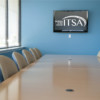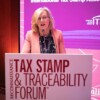
On The Record with Gerben van Wijk, Luminescence Sun Chemical Security
13 Jun 2023 | Interviews
Gerben van Wijk is Sales and Marketing Director of Luminescence Sun Chemical Security (LSCS) and has been a Board Member of the International Tax Stamp Association since 2018, taking over as Chair in May 2022.
In a recent interview, he sat down with Tax Stamp & Traceability News™ to explain the origins and development of LSCS and its role in the tax stamp industry. He also looked to the future of tax stamps – how they’re likely to develop over the next few years and where challenges are likely to arise – and examined the importance of standards in shaping their evolution.
Q: Could you please introduce your company and its products/services.
A: Luminescence Sun Chemical Security was formed in 2018 after the acquisition of Luminescence International Ltd by Sun Chemical. Luminescence’s history began with four brothers starting a business in the UK focusing purely on security inks. They didn’t want to do anything else! They just served the security market of the time, which included things like fluorescent and phosphor inks used for postage stamps.
Over the course of 30 years, their portfolio grew to cover all sorts of inks for processes like offset, intaglio, flexographic, screen and gravure, and security features like fluorescent, photochromic, thermochromic, magnetic, IR transparency and a wide variety of other security inks.
Sun Chemical – the world’s largest provider of ink, pigments and coatings – has a history stretching farther back, to the early 1800s in France. At the time they acquired Luminescence, their security division was a very small part of the business, and they worked on a regional basis, offering an entire product portfolio to each individual region. Post-acquisition, they shifted to a more market-oriented set-up that revolves around products and technologies, rather than geography.
Nowadays, Sun Chemical’s security division covers inks, novel devices, authentication equipment, stitching threads, pre-laid holographic inlays, and lamination plates for passports.
LSCS serves countries around the globe with products used in banknotes, identification (such as passports, ID cards and visa stickers), generic security documents like certificates, and – this is where tax stamps come in – product markings.
Even with this expansion, we’ve maintained the original Luminescence focus on security inks while combining it with authentication technologies (see also page 1). Some other companies tend to be full-service suppliers, whereas our approach is to partner with other specialist organisations, rather than competing with them.
Q: What is the most interesting aspect of the tax stamp industry as far as you are concerned?
A: For me, it is how everyone takes a different approach to finding solutions to a common issue. At the heart of it, we need to raise revenue for the authorities of a given country, and to do that effectively and sustainably, the products must be secure. The sheer variety of solutions to this is fascinating.
Q: What changes are you currently seeing in the tax stamp industry?
A: The primary change we’re seeing is an ever-expanding range of applications. For example, tax stamps are no longer just a 40mm x 20mm sticker applied to an alcohol or tobacco product. They can now be direct marks on a product, such as on lids or other packaging. Ink is naturally a key component of that. Also, the variety of products that carry a ‘tax paid’ mark is growing every day.
Q: What changes do you envisage happening within the industry over the new few years?
A: I think the industry is likely to grow in terms of where tax stamps are needed, which will in turn increase the range of tax stamps required. In many places, it’s not just alcohol and tobacco but also products like cosmetics, soda, or water – and in some countries even cement – that now require tax stamps.
Beyond that, it’s hard to think of a product type that isn’t currently being considered as a candidate for adding tax stamps. I think the upcoming challenges we’ll see as an industry will be related to that, which is exciting. I’m anticipating a range of solutions being developed, and the breadth and creativity of those will be very interesting.
Q: What is one change to tax stamps or the industry that you would like to see?
A: What I’d like to see going forward is the industry ensuring tax stamps remain a complex, physical product. In particular, I don’t think we want to reach a point where, for example, one single technology is employed in creating them.
A simple barcode printed on the side of something won’t be sufficient. There should preferably be deeper security elements, such as a ‘hidden barcode’ that requires special equipment to read, or fluorescent or magnetic inks.
What we need is a comprehensive and holistic security document that provides constant reassurance of authenticity and the payment of relevant taxes.
Q: What do you see as your key role as Chair of the International Tax Stamp Association (ITSA)?
A: I see a key part of my role as emphasising the importance of the physical nature of tax stamps – with multiple layers of security – to provide a seal that guarantees not just that tax has been paid on a product, but also that the product is authentic.
A secondary part of my role is to support the industry – both on the supply and the customer side – in creating an ethical, level playing field where tenders are won on technical merits and not through political connections.
Q: Why do you think the development of standards is important for the industry?
A: Standards play a key role in shaping the industry and maintaining its integrity, and that will continue to be the case as it develops. Without standards, we would risk everyone pulling in different directions. We could end up being led by the preferences of a particular company or industry, for example, and if we stray onto multiple paths, we’ll end up losing sight of the reliability of a physical document governed by consistent rules.
As the industry develops and grows, standards will enable revenue authority inspectors to check and control an increasing range of products, and both they and the general public will be able to have absolute confidence in tax stamps. For this reason, ITSA is currently reviewing ISO 22382:2018, which will provide guidance on tax stamps, and we plan stronger advocacy around this topic going forward.







